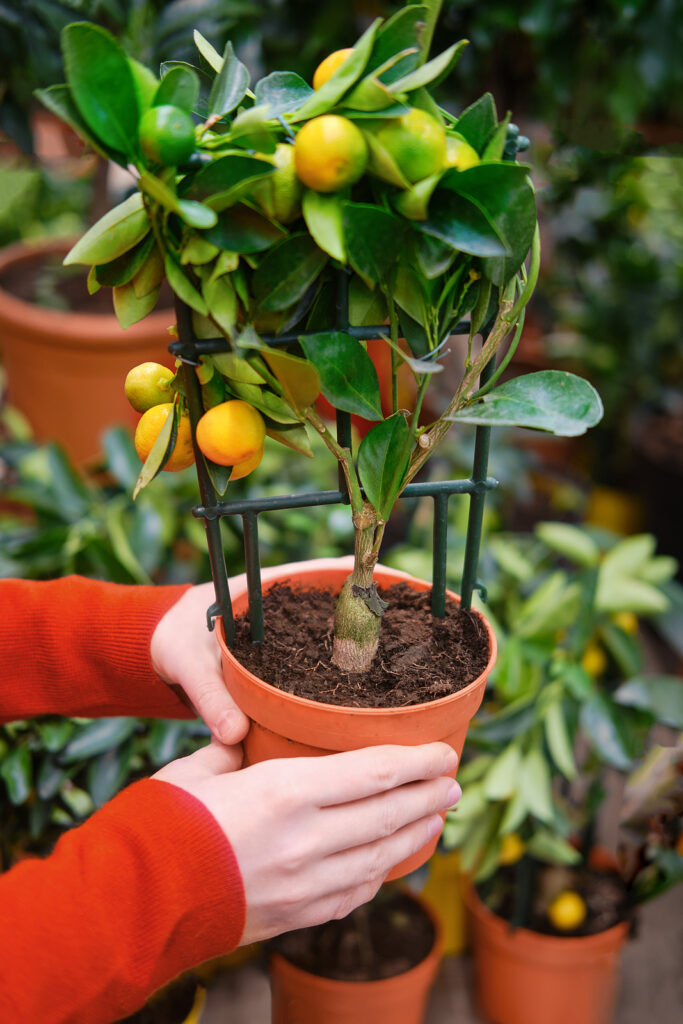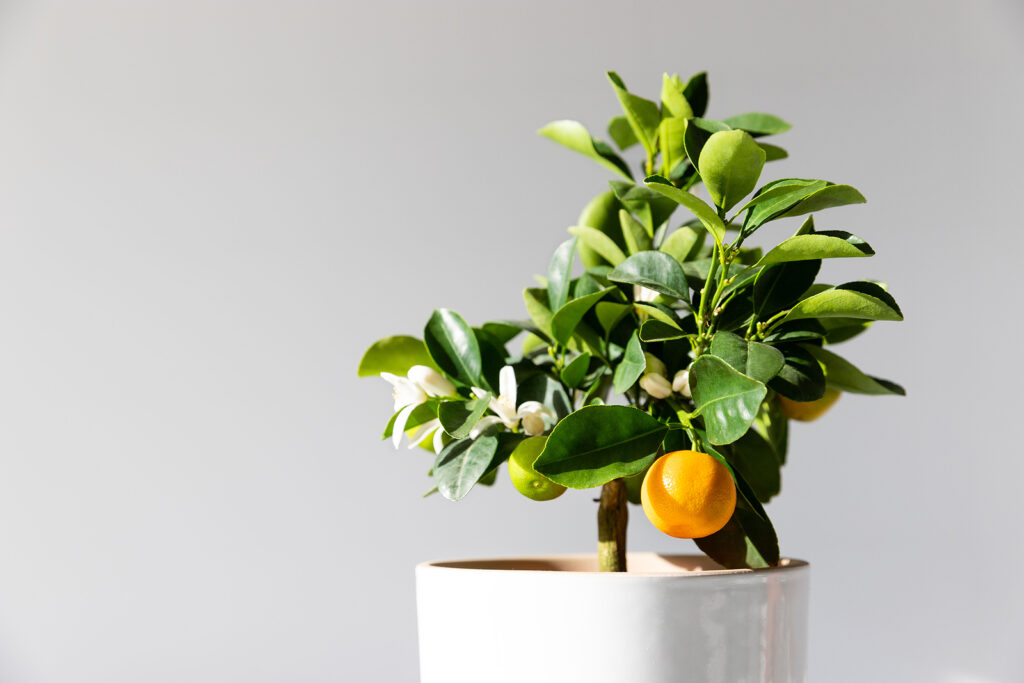Citrus are subtropical, fruit-bearing trees. They can be grown as specimens outdoors and many can be grown indoors. Citrus include limes, oranges, lemons, citrons, grapefruits, mandarins, clementines, satsumas, and tangerines.
Nearly all citrus have thick, leathery, and shiny green leaves and stems that are often spiny. They bear handsome flowers that are fragrant, white and up to 2 inches across. Flowers appear in clusters most abundantly in spring and fall. Flowers are followed by edible fruits that last on the plant for several months.
Generally, sweet-fruited Citrus needs moderate to high heat to produce sugars; sour varieties need less heat. Lemons and limes require the least warmth and can be grown where summers are cool. Navel oranges and mandarins demand the most heat and should be grown where summers are very warm or hot. Grapefruits demand prolonged high heat.
Some Citrus have cold resistance. Kumquats, satsuma mandarins, sour oranges, and calamondin are the most cold-resistant with kumquats able to withstand temperatures in the high teens. All Citrus is damaged by prolonged exposure to freezing temperatures.
Citrus can be grown as patio plants or houseplants in containers. In pots, Citrus grows from 2 to 15 feet (.6-4.5m) tall, depending on the variety. Calamondins are probably the best Citrus houseplants, but limes, sour oranges, lemons, and sweet oranges can also be grown indoors. Indoors.
Citrus grows best in full sun outdoors; indoors grow Citrus with full sun from a southern exposure.
Get to know Citrus
- Plant type: Evergreen trees and shrubs
- Growing zones and range: Zones 9-11
- Hardiness: Citrus grow best between 55°F (13°C) and 85°F (29°C). They can tolerate warmer or cooler temperatures (down to about freezing or below depending on the variety) for very short periods of time. They require a 5-10 degree difference in day and night temperatures for flowering.
- Optimal growing temperature: day 69° to 72°F (21°-22°C), night 50° to 55°F (10°-13°C).
- Height and width: The height and spread of the plant listed below are for specimens planted in the garden or orchard; plants in large pots will reach only half of these sizes; plants in smaller pots can be kept smaller.
- Foliage: Thick, leathery, glossy, oval green leaves; stems are often spiny
- Flowers: Flowers are fragrant, waxy white, lobed up to 2 inches across; flowers have five oblong petals that curve outwards and prominent stamens; blooms usually appear in clusters.
- Bloom time: Spring and fall
- Fruit: Edible fruit follow flowers; fruits last on the plant for several months
- Uses: Edible fruit, garden, houseplant
- Common names: Citrus, lime, orange, lemon, citron, grapefruit, mandarin, clementine, satsuma, tangerine
- Botanical name: Citrus
- Family name: Rutaceae
- Origin: Subtropical and tropical regions of Asia, Island Southeast Asia, Near Oceania, and northeastern Australia.

Where to plant Citrus
- Light outdoors: Grow Citrus in full sun.
- Light outdoors: Full sun from southern exposure.
- Soil outdoors: Grow Citrus in average to rich well-drained soil; fast drainage is essential.
- Soil indoors: Grow Citrus in a slightly acidic all-purpose soil mix.
When to plant Citrus
- Set container-grown Citrus outdoors in spring or fall. Summer-planted Citrus should be protected fom mid-day sun until plants are well-established.
Planting and spacing Citrus
- See width of plants below. Be sure plants are well-spaced and have plenty of air circulation.
How to water and feed Citrus
- Water: Water Citrus freely in spring and summer, sparingly in winter; when watering keep the soil evenly moist. Indoors, mist Citrus daily. Humidity of 45% to 60% is optimal.
- Feeding: Fertilize Citrus monthly with a mild liquid fertilizer.
Citrus care
- When plant is in full bloom, shake it slightly to ensure pollination and the setting of fruit.
- Pinch growing tips to keep the plant compacts.
- During spring prune out any weak wood or any wood that has died back over winter; shorten lateral shoots by at least a third.
Growing Citrus as a houseplant
- Cirtus grows best indoors under high light, in warm temperature, and high humidity.
- Pot Citrus in average, slightly acid growing medium.
- Allow the medium to dry out slightly between waterings.
- Fertilize in early spring, in early summer, and in late summer.
Citrus pests and diseases
- Check Citrus for scale insects, whiteflies, and spider mites.
- Citrus can be afflicted with rust and scab/
- Lack of soil acidity may cause yellow mottling of leaves
Citrus propagation
- Propagate Citrus with stem cuttings taken between midsummer and late fall.
- Most Citrus are professinally grafted on to a citrus rootstock, but for an amateur semi-ripe cuttings in summer is the best method.

Citrus varieties to grow
- Citrus aurantiifolia, lime. Grows to 16 feet (5m) tall and wide; glossy oval leaves; spiny branches, waxy white flowers followed by green fruits 2 inches across.
- C. aurantium, bitter orange, Seville orange. Grows to 30 feet (10m) tall and 10 feet (3m) wide; rounded crown, oval leaves; fragrant waxy white flowers followed by orange spherical fruit 3 inches or more across.
- C. limon, lemon. Grows to 16 feet (5m) tall and wide; glossy oval leaves; white flowers with purplish tinge followed by oval yellow fruits to 4 inches long. Cultivars include ‘Eureka’ and ‘Meyer’ with yellow fruit; ‘Ponderosa’, wonder lemon, has orange-yellow, rought skined 4-inch fruit.
- C. x limonia, Otaheite orange. Small, thornless plant with deep hellow ro oragne, 2-inch, seer fruit.
- C. maxima, shaddock. Grow to 16 feet tall (5m) and 10 feet (3m) wide; rounded crown; glossy leaves; white flwoers followed by orund yellow fruit to 6 inches across.
- C. medica, citron. Grows to 10 feet (3m) tall and 6 feet (2m) wide; shrubby tree; oval drk green leaves; branches may be flushed purple when young; whtie flowers with pink blush followedby yellow fruit to 8 inches long.
- C. x meyeri, Meyer’s lemon. Small tree 10 feet (3m) tall and 5 fet (1.5m) wide; oval glossy leaves; white flower followed by oval yar fruit; hardiest lemon; best choice for growing indoors.
- C. mitis, calamondin. Grows 8 to 10 fet tall; columnar growth; fruit looks like a small orange.
- C. x paradisi, grapefruit. Rounded crown grows 16 feet (5m) tall and 10 feet (3m) wide; dense dark green foliage; waxy white flwoers follow by large, globular fruit to 6 inches across.
- C. reticulata, mandarin, clementine, satsuma, tangerine. Shrub or small tree to 6 feet (2m) tall and wide; glossy oval, dark green leaves; waxy white flowers followed by yellow-orange to orange-red fruit.
- C. sinensis, sweet orange. Grows to 30 feet (10m) tall and 13 feet (4m) wide; spiny branches; glossy oval leaves; waxy white flowers followed by orange to yellow fruits. Cultivars include ‘Valencia’ and ‘Washington’ is seedless and thick skined wiht a prominent navel.
- C. x tangelo ‘Seminole’ tangelo. Hybrid between grapefruit and mandarin; grows to 16 feet tall (5m) and 6 feet (2m) wide; waxy white flowers followed by yellow or reddish orange fruit up to 5 inches across.
- Fortunella japonica, kumquat. Round, deep orange 1 inch, sweet-tasting fruit.



